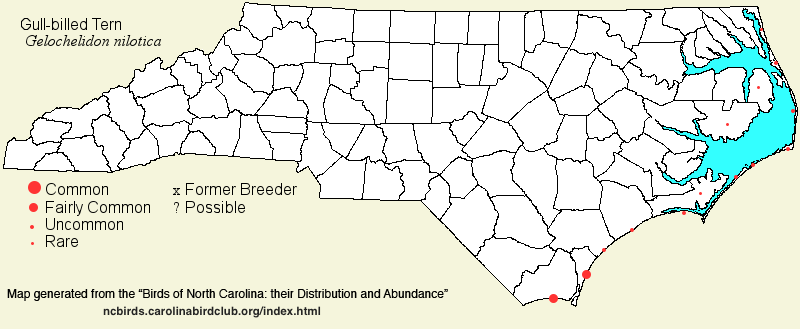 |  |
|
Gull-billed Tern - Gelochelidon nilotica LARIDAE Members: | Search Common: Search Scientific: |
|
|
|||||||
| General Comments | Of all of the breeding species in North Carolina, few are as strongly declining over the past decade as the Gull-billed Tern, and it is a State Threatened species. Why this species is declining more severely than the other ground-nesting colonial waterbirds (such as Least, Common, Royal, and Sandwich terns, and Black Skimmers) is not certain. Unlike other coastal terns, this species feeds over coastal grasslands, dunes, and marshes, where it plucks prey such as lizards and grasshoppers from vegetation; it usually does not feed at water. However, along the coast, they do rest on sandbars and spits with other terns. This species is almost strictly coastal, and any report of one far inland is typically met with skepticism. In addition to being almost strictly coastal, it is quite an early fall migrant, and late fall reports, much less those in the winter, are also met with raised eyebrows, as well. | ||||||
| Breeding Status | Breeder | ||||||
| NC BRC List | Definitive | ||||||
| State Status | T | ||||||
| U.S. Status | |||||||
| State Rank | S2B | ||||||
| Global Rank | G5 | ||||||
| Coastal Plain | Breeding summer resident, along and near the coast. Uncommon to fairly common -- fairly common prior to 2000 -- but strongly declining along the southern half of the coast, north to Carteret; and generally uncommon (since 2000) northward along the coast. Rare to uncommon in the Tidewater zone, though it does occur in freshwater areas such as Lake Mattamuskeet and Lake Phelps on occasions, and there are a few records as far inland as Aurora (Beaufort); nests sporadically on islands along the mainland side of Pamlico Sound. Nests on both small coastal islands and on barrier islands. Only one far inland record: an adult at Buckhorn Reservoir (Wilson), on 11 May 2015 [Chat 79:134 link], after the passage of Tropical Storm Ana a few days earlier. Normally present from early Apr to mid-Sep, rarely to early Oct. No valid records in Nov, Dec, Jan, and Feb -- except for one photographed at Oak Island (Brunswick) on 3 Nov 2022 and another photographed on 1 Nov 2024 at Pea Island NWR (Dare) -- though there are a handful of such published reports. Peak counts: 332 (post-breeding), Davis (Carteret), 15 Aug 2021; 160 (post-breeding), same site, 19 Aug 2012; 140 (post-breeding), same site, 8 Aug 2018; 110 (post-breeding), same site (Carteret), 28 Jul 2002; 85 (post-breeding), North River Farms (Carteret), 8 Aug 2004. | ||||||
| Piedmont | Accidental/casual, presumably a storm-carried visitor, but whether these reports were actually related to storms is not mentioned in the literature. Records are of 3 near Raleigh on 4 Sep 1967, with 1 there on 7 Oct 1967; and 1, Salem Lake, 15 Jul 1975. | ||||||
| Mountains | Accidental, after storms. One in the Mills River area (Henderson) on 17 Sep 2004 [Chat 69:52 link]. | ||||||
| Finding Tips |
A few Gull-billed Terns can be usually be seen at Pea Island, at Fort Fisher, and at many areas along the coast, but with each passing year, it is not the gimme it used to be -- thus best called as "may see" to "probably should see". They can be seen swooping over marshes and even dunes, looking for lizards, grasshoppers, and other terrestrial animal prey. Because they depart early, your best chances are from late Apr to late Jul. ** to *** | ||||||
| Attribution | LeGrand[2025-04-21], LeGrand[2025-01-30], LeGrand[2023-03-18] | ||||||
| NC Map Map depicts all counties with a report (transient or resident) for the species. | Click on county for list of all known species. |
| NC Breeding Season Map Map depicts assumed breeding season abundance for the species. |  |